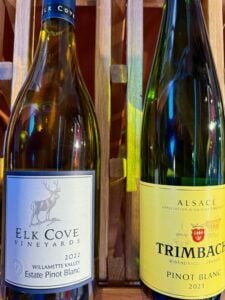Spring is about to bloom (I hope), and this is a time of year that I tend to transition from the fuller-bodied reds of winter to lighter style white wines that are more suitable to the foods we consume in the warmer months.
What I love about wine ā among the most obvious sensory pleasures it provides ā is the diversity of experiences it offers to us if we are adventuresome.
I suppose the essence of wine appreciation, then, is variety.
Unfortunately, when most of us discover a wine that is pleasing to our palates, we stick with it as if there were no other alternatives. Itās almost as if youāre stuck in a wine rut and find it difficult to abandon that tried-and-true bottle of chardonnay, pinot grigio or sauvignon blanc youāre accustomed to selecting.
Iāll use myself as an example. I truly do enjoy chardonnay in all its stylistic permutations ā from austere and unoaked to rich and full-bodied. Iāve sipped chardonnay from Australia to France, from Italy to California, and even from those vintners over the mountains in (East) Virginia. However, I hope to convince you to wander outside your wine comfort zone and discover the pleasures that abound in the wide world of wine.
Today Iām going to tell you about a white wine that offers a tasty alternative to the āsame-old, same-old.ā I hope youāll give this wine a chance, because itās an especially good alternative to chardonnay.
Recently, I was shopping for a white wine that would pair well with the filet of grouper that I intended to grill and drizzle with lemon and butter for dinner that evening. Resisting my tendency to grab a bottle of chardonnay, I chose instead a pinot blanc from Alsace in eastern France. I was not disappointed!
Pinot blanc is a grape that produces an excellent, medium-bodied, crisp, white wine. It can also exhibit a creamy texture with rich, ripe apple flavors. The grape thrives in regions with cool climates and long growing seasons, like Alsace. It also does well in northern California and in Oregon.
In Alsace, the wine has a quality to the taste that I can only describe as āslate.ā No, it doesnāt taste like a blackboard. But it does have a mineral nuance that differentiates pinot blanc produced in Alsace from the stuff made anywhere else.
In the US, pinot blanc shows less minerality, but it still offers crisp and round flavors, especially from grapes grown and vinted in California and Oregon.
Pinot blanc is a perfect match to oysters on the half-shell or to broiled white fish such as sea bass, halibut or grouper. It is also a delicious accompaniment to delicate veal or chicken dishes, and it holds up well to cream sauces. Iāve often used it to accompany turkey at Thanksgiving, and Iāve even featured it as an aperitif with hors dāoeuvres.
My favorite Alsatian pinot blanc producers are Marcel Deiss, Lucien Albrecht, Domaine Schlumberger, Hugel, and Trimbach. Most Alsatian pinot blanc is priced between $20 and $40 a bottle.
The wine is also made in northern California as well as in Oregon. In California, I suggest you try Bouchaine from Carneros, Dutton-Goldfield from the Russian River Valley and Handley Cellars from Mendocino County.
In Oregon, look for bottles of Elk Cove, WillaKenzie Estate and St. Innocent priced from $30 to $45.
You can find these lovely pinot blancs at the Wine Shop at Capitol Market and at other local wine retailers.
Enjoy!











